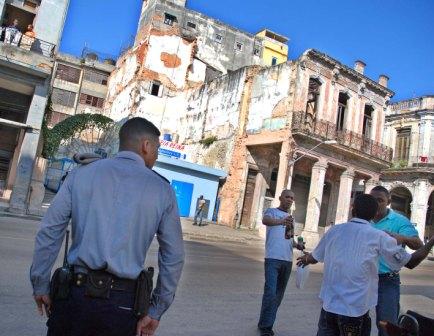A Frivolous Depiction of Havana
Daisy Valera

Four-hundred and ninety years have passed since the founding of Havana, the Cuban capital, and on various street corners one can find banners in commemoration of this historic event. Every day Havana gets a little older. Yet when I saw how this anniversary was highlighted in the newspaper, I couldn’t avoid a sense of repulsion.
A page in Granma displayed the title “Havana and Its People,” but instead of taking it as a serious feature article, I felt more like I was browsing through a glib tourist magazine.
The first photo showed a placid Havana bay with the hallowed statue of Christ towering above it. The feature continued with the old women who masquerade around as Afro-Cuban santeria disciples, dressed all in white and wearing necklaces and flowers in their hair (while in fact these women earn a living charging tourists for taking photos of them).
The articles concluded with shots of several tourists riding in a horse-drawn colonial coach near the Plaza of the Cathedral.
In Havana -undoubtedly a beautiful city- we can indeed see these images; they’re not anyone’s invention. But if you’re going to put them in the “official organ” of the Communist Party on a page dedicated to “Havana and its people,” I’d expect a little more seriousness and realism.
If we thought about what this city and its people really were, there would surely come to our minds millions of images more valuable than these little touristy snapshots.
The real Havana can be represented in the endless morning lines of people waiting for the buses, workers on any job here in the capital, doctors in hospitals, rundown neighborhoods in every district of this capital, or children playing in the courtyard of any school.
Any such image would be much more representative of what this city has been over its 490 years of existence.
A city is not summed up in how many images of it can be sold; a city can only be represented in the progress achieved by its people and in the difficulties that remain for them to overcome.






The real story can only be approached through short stories and novels, through photos (as evokative as HT’s Caridad), through paintings, through music, through memoirs of the past, present and future; through diaries (such as your own, Daisy). Habana’s real story takes a lifetime to tell–in fact, many lifetimes. It can be concentrated, but the one who distills must be a skilled “brewmaster.” Such distilled examples do exist: (for example, Lezama Lima’s Paradiso for the Habana of the 1940’s and 1950’s; ditto Cabrera Infante’s Tres Tristes Tigres for the Habana of the 1950’s; Alexanderplatz for Berlin; Woody Allen’s Manhattan, etc. You are unlikely to find such examples in the pages of Granma. I am sure there are other publications in Cuba which are more likely to contain examples which are more representative of the Habana beyond the artificial environment of Habana Vieja (though I am appreciative of the great restoration works which have and are going on there).
I enjoyed reading your article Daisy and as a tourist from the UK, I found all of Cuba fascinating, particularly Havana.
I hope you don’t think all tourists appreciate seeing old ladies dressed in Santeria clothes and those smoking enormous cigars for tourist photos.
Whilst staying in Havana, I would leave the Hotel at day break and walk the streets watching Cuban life and trying to learn more about Cuban culture.
I shall be returning to Cuba in 2010 and hopefully gain further insight into Cuban life.
Daisy, great post.